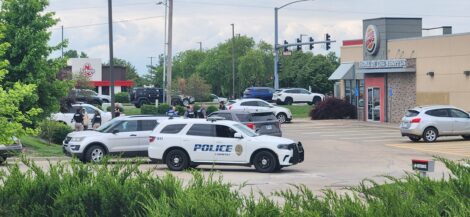Lawrence school district will soon be testing ‘mobile panic buttons’ for staff members

photo by: Matt Resnick/Journal-World
The "CrisisAlert" badge that will soon be distributed to selected staff members in the Lawrence school district.
Some employees in the Lawrence school district will soon be equipped with high-tech badges that can call for help in a variety of situations — from a fight between students to a threat requiring a school lockdown — with just a few clicks of a button.
The badges are part of a system called CrisisAlert, which is described on service provider Centegix’s website as a “mobile panic button.” It’s already in use by Olathe and several other Kansas City-area districts, said Larry Englebrick, the Lawrence district’s chief operations officer, and soon it will get a trial run at six elementary and middle schools in Lawrence.
“We continue to look for ways to keep students and staff safe,” Lawrence school board member G.R. Gordon-Ross told the Journal-World. “And this allows us a way to address problems and situations in real time.”
Englebrick described for the Journal-World how the badges are intended to work. Each badge has a button on it that can send an alert to building administrators or emergency responders. Staff will be trained to press the button in specific patterns to send alerts about different kinds of scenarios; that includes both nonemergency situations, like an employee falling and needing help or a lunchroom or playground fight, as well as violent incidents and other emergency situations that would require a complete school lockdown.
For scenarios that don’t require a lockdown, the alert goes to designated administrators and office staff in the building. But for emergency scenarios that would require a lockdown, the alert is transmitted to emergency dispatchers.
The system is capable of sending “precise location details, facilitating swift and targeted response to incidents within buildings,” according to a school district memo about the system.
Englebrick said the system would be more efficient than the walkie-talkies that some staffers currently use in emergencies. He said that all staff members at each school would have access to it, and that it would give staff “the ability to communicate without a level of disruption.” And Gordon-Ross said the technology allows users to “convey a lot of information very quickly without having to convey it verbally.”
It will also be partly funded by the state, Englebrick said. Half of the pilot program’s cost is covered by a Kansas Safe Schools grant of just over $142,000, and the other half is from the district’s Facilities and Operations Safety and Security Capital Outlay Fund. The school board approved that spending on Nov. 27.
Englebrick said that training on the system would take place in late February and that he hoped the system could roll out shortly afterward. But he said it would be important to test the system at just one school before widening the program to include multiple buildings.
“We do believe that it is worth our time to take a 10-day or even two-week period to turn it on in one of our buildings, see how it works and get feedback from our administrative team,” Englebrick said, “rather than doing it at six schools and having people all over the place.”
Englebrick said the initial testing should be done at a smaller school, and that Woodlawn’s administrators had expressed interest in being the first to try it out. Even if Woodlawn is first, five other schools will also be part of the pilot program at some point: Cordley, Deerfield and Sunset Hill elementary schools and Billy Mills and Liberty Memorial Central middle schools.
“We want to see not only how it will work in a smaller school like Woodlawn, but also in a larger school and a secondary school,” Englebrick said.
Right now, the equipment necessary to send and receive the signals is still being installed in those six schools. Englebrick said that so far, 14 external antennas had been attached to the buildings and that there would also be tamper-proof equipment inside the buildings, placed on the walls or ceiling, to receive signals sent by the badges. Englebrick said the installations should be complete by later this week.
Once the training is complete and the system goes online, Englebrick said administration would be closely monitoring “how well the system rolls out and works for our buildings,” and that adjustments could be made as the pilot period went along.

photo by: Contributed
External antennas associated with the “CrisisAlert” technology.
CrisisAlert isn’t the only safety system the district has added in recent months. Last fall, the district started using a software system called Gaggle, which monitors what students type on their district-issued electronic devices around the clock and sends alerts to staff if it detects concerning content. As the Journal-World reported, that system caused some confusion in the district when it went online in November; Gordon-Ross said that some staff members were “inundated” with more alerts than they expected, and Superintendent Anthony Lewis said the rollout “was not as seamless as we had hoped.”
Englebrick said the goal for CrisisAlert was to introduce the new system as smoothly as possible.
“A smooth rollout is supportive to the buildings and not an interruption to (staff’s) flow of work,” Englebrick said. “We’re always looking at how we can do things and be less disruptive to our buildings.”
Gordon-Ross, who is a software developer, said district stakeholders would likely have questions about the new technology as it rolled out.
“The biggest questions are always ‘Why this? Why now? Why don’t we just keep doing what we’re doing?'” he said. “As a school board member, I’m trying to be very mindful of really looking at when is the right time to make a change and when is the right time to say, ‘Let’s not do that now.’ And I felt this was warranted.”
If all goes well, Englebrick said, the hope is to eventually implement the panic buttons districtwide.
“By the end of the school year, we want to be in the process of preparing to expand this,” he said.






